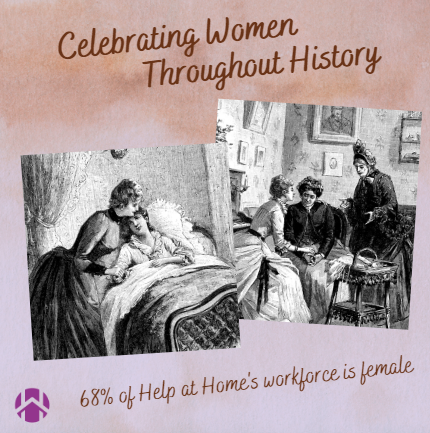Women’s History Month: Celebrating Women and their Traditional Role as Caregiver

As Women’s History Month comes to a close, we’d like to take a moment to reflect on the ties between women and the role of caregiver. Help at Home, in its 45+ year history, has been a company built on the premise of people caring for people in need. Considering the company’s current day workforce is 68% female, it’s interesting to note that the role of caregiver has been historically and still is heavily dominated by women.
Traditionally, women have been the ones who are most likely to step into unpaid caregiving roles for aging or disabled parents, in-laws, and spouses. Caregiving is not limited by gender – but we also recognize that this important work is currently being done predominantly by women. Help at Home is proud to be an organization that is committed to elevating and professionalizing the caregiving role, as well as offering in-home personal caregiver and paid family caregiving careers.
Taking a quick peak at history, numerous notable female caregivers stand out. As early as the 1920s, Eleanor Roosevelt cared for Franklin Roosevelt after his polio condition left him paralyzed. She continued her advocacy for those who had no one to care for them. Moving on a few decades to the 1980s, and another First Lady, Rosalynn Carter, started the Rosalynn Carter Institute for Caregivers.
Caregivers are an invaluable asset to society and can mean almost everything to their clients – a keystone to living safely, especially at home and when there is no other family or loved one to assist.
Fast forward to today, paid caregiving is also most often done by women. PHI (Paraprofessional Healthcare Institute) says that more than 85 percent of professional caregivers identify as women.
And, women currently make up 61 percent of unpaid caregivers, according to a 2020 report from the AARP. The economic value of that unpaid work is estimated at $600 billion – but, of course, it’s priceless to the family members who depend on it.
While it may be tempting to think of this caregiving as simply an act of love, the truth is more complicated. About 44 percent of caregivers say they feel they have no choice other than to take on the role of caregiver – and can often come at a cost. That’s where a paid family caregiver career can be a solution in many cases and a win-win in situations where family taking care of another family member in need is preferred.
Of course, most families sincerely want to take care of each other. Most adults – no matter what their gender – want to help an aging parent and they also expect to care for a sick spouse. But too often, families are faced with impossible choices. That’s why professional caregivers – like those at Help at Home – are so important.
We celebrate the rich caregiver history in this country, the present-day roles of caregivers both women and men – especially our 50,000+ caregivers. We are committed to high-quality, in-home personal caregiving services and understand how it deeply impacts our society’s health and well-being now and in the future for aging in place seniors, the underserved and hard to reach dual-eligible populations who want to live as safely and independently as possible in their own homes.
